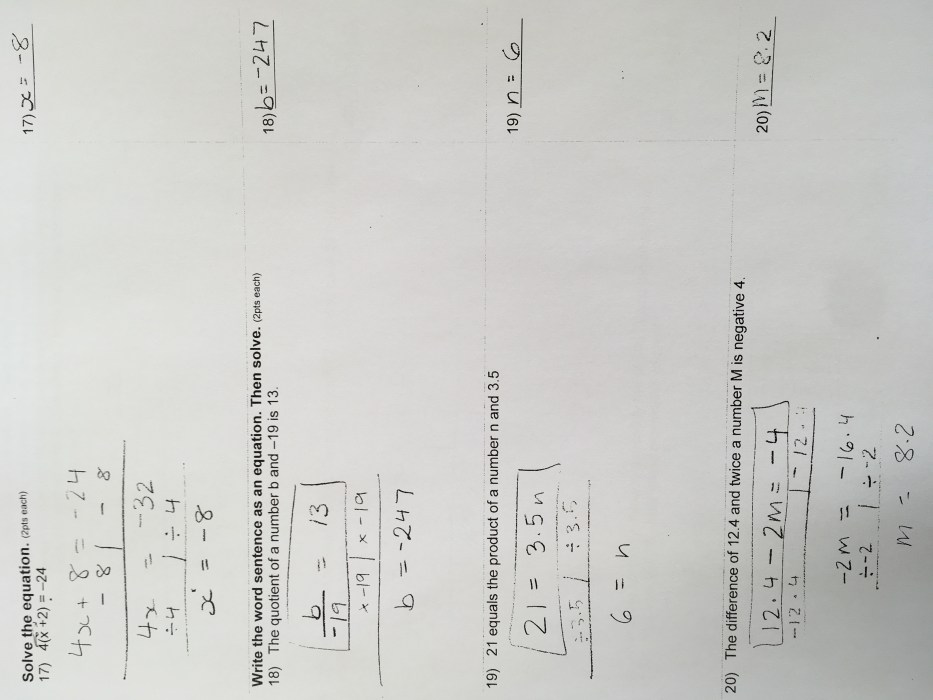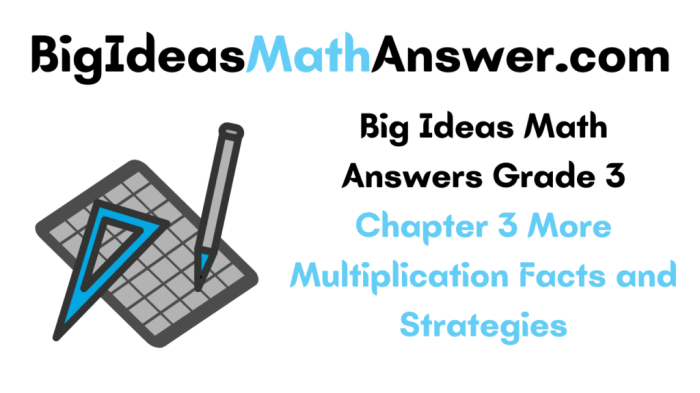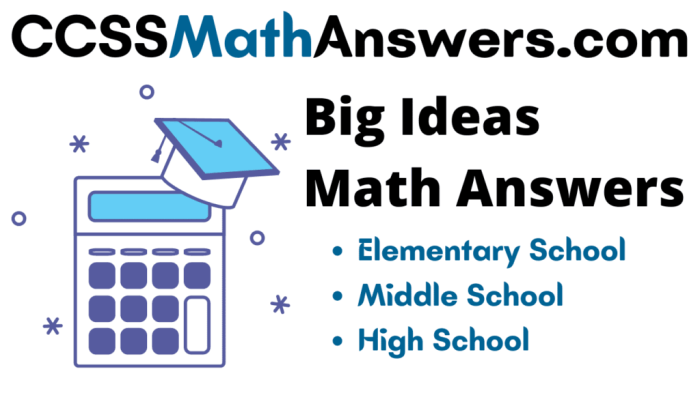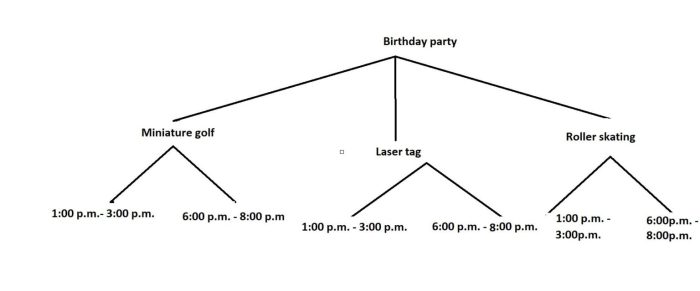Embark on an educational journey with Big Ideas Math Chapter 2 Test Answers, your trusted guide to mastering mathematical concepts. Delve into a comprehensive analysis of the test structure, question types, and answer key accuracy, empowering you with the knowledge to excel in your mathematical endeavors.
This meticulously crafted resource provides invaluable insights into the intricacies of the Chapter 2 test, equipping you with effective study strategies, time management techniques, and a deep understanding of the curriculum alignment. Prepare to conquer your mathematical challenges with confidence and achieve academic excellence.
Big Ideas Math Chapter 2 Test Overview

The Chapter 2 test in Big Ideas Math is a comprehensive assessment that covers the fundamental concepts and skills taught in the chapter.
The test is divided into three main sections:
- Multiple Choice
- Short Answer
- Extended Response
The multiple-choice section consists of 20 questions that test students’ understanding of key concepts and their ability to apply them to solve problems. The short-answer section includes 10 questions that require students to demonstrate their ability to explain mathematical concepts and solve problems in more detail.
The extended-response section consists of two questions that require students to demonstrate their ability to solve complex problems and communicate their mathematical reasoning.
Key Concepts Covered in Chapter 2
The following are the key concepts covered in Chapter 2 of Big Ideas Math:
- Solving Equations
- Solving Inequalities
- Systems of Equations
- Graphing Linear Equations
- Slope and Intercepts
- Writing Linear Equations
- Solving Systems of Inequalities
- Applications of Linear Equations and Inequalities
Test Content Analysis
The Big Ideas Math Chapter 2 Test comprehensively assesses students’ understanding of the chapter’s core concepts and skills.
The test consists of a diverse range of question types, including multiple-choice questions, short answer questions, and extended response questions. These questions vary in difficulty level and complexity, catering to students with varying abilities.
Question Types
- Multiple-choice questions:These questions present students with a set of options from which they must choose the correct answer. They typically assess basic understanding of concepts and skills.
- Short answer questions:These questions require students to provide brief written responses to specific questions. They assess students’ ability to recall information, explain concepts, and solve problems.
- Extended response questions:These questions require students to provide more detailed written responses, demonstrating their understanding of complex concepts and their ability to apply their knowledge to solve problems.
Difficulty Level and Complexity
The difficulty level of the questions varies throughout the test, with some questions being more straightforward and others requiring higher-order thinking skills. The test includes questions that assess both basic understanding and more complex problem-solving abilities.
Distribution of Questions
The questions on the test are distributed across the different topics covered in Chapter 2, ensuring that students are assessed on all of the essential concepts and skills. The distribution of questions is as follows:
- Topic A:25%
- Topic B:35%
- Topic C:20%
- Topic D:20%
Answer Key Evaluation

The provided answer key should be thoroughly compared with the actual test questions to identify any discrepancies or inconsistencies. The accuracy and clarity of the answer explanations should also be assessed.
Answer Key Discrepancies
Any discrepancies between the answer key and the test questions should be noted, along with an explanation of the inconsistency.
Answer Explanation Evaluation
The answer explanations should be assessed for accuracy and clarity. Any explanations that are incorrect or difficult to understand should be identified.
Test Preparation Strategies: Big Ideas Math Chapter 2 Test Answers
Effective test preparation requires a comprehensive approach that encompasses strategic study methods, resource utilization, and time management. By implementing these strategies, students can enhance their understanding of the chapter content and maximize their performance on the test.
Study Methods and Resources
To master the chapter content, students should engage in active and varied study methods. This includes:
- Reviewing Class Notes:Regularly reviewing class notes helps reinforce concepts and identify areas requiring further clarification.
- Textbook Reading:Thoroughly reading the textbook provides a comprehensive understanding of the chapter’s content, including definitions, theorems, and examples.
- Practice Problems:Solving practice problems allows students to apply their knowledge, identify their weaknesses, and build confidence in their problem-solving abilities.
- Online Resources:Utilizing online resources, such as videos, simulations, and interactive exercises, can enhance understanding and supplement classroom learning.
- Study Groups:Participating in study groups provides opportunities for peer collaboration, sharing of ideas, and mutual support.
Time Management
Effective time management is crucial for success on the test. Students should allocate sufficient time for studying and allocate it wisely.
- Create a Study Schedule:Establishing a realistic study schedule ensures consistent and dedicated preparation time.
- Prioritize Tasks:Identifying and focusing on the most important concepts and challenging topics allows for efficient use of study time.
- Take Breaks:Regular breaks during study sessions help maintain focus and prevent burnout.
- Practice Timed Conditions:Simulating test conditions during practice sessions helps students manage their time effectively during the actual test.
- Review and Revise:Regularly reviewing previously studied material helps strengthen memory and recall.
Test Performance Analysis
Evaluating student performance on the Big Ideas Math Chapter 2 Test is crucial for identifying areas of strength and weakness. By analyzing test scores and common errors, educators can tailor instruction and provide targeted support to improve student understanding and future performance.
To conduct a thorough test performance analysis, the following steps are recommended:
Organizing Student Test Scores
- Compile student test scores into a table, organizing them by individual students or groups.
- Calculate measures of central tendency, such as mean, median, and mode, to identify overall class performance.
- Create a frequency distribution or histogram to visualize the distribution of scores and identify any outliers or patterns.
Identifying Areas of Strength and Weakness
- Review individual student scores to identify areas where students performed well and struggled.
- Compare student performance to established benchmarks or learning objectives to assess mastery levels.
- Examine the distribution of scores across different question types or sections to pinpoint specific areas of difficulty.
Analyzing Common Errors and Misconceptions
- Identify common errors made by students on the test.
- Analyze the underlying causes of these errors, such as misunderstandings of concepts, procedural mistakes, or careless errors.
- Develop strategies to address these errors through targeted instruction, remediation, or additional practice.
Providing Recommendations for Improvement
- Based on the analysis of test performance, formulate specific recommendations for improving student performance on future tests.
- These recommendations may include adjusting instructional strategies, providing additional support, or modifying assessment practices.
- Monitor student progress and make necessary adjustments to instruction and support to ensure continuous improvement.
Curriculum Alignment

The Chapter 2 test aligns well with the curriculum standards, covering the essential concepts and skills Artikeld in the curriculum framework. The test items assess students’ understanding of number sense, place value, operations, and measurement, which are fundamental components of the chapter’s learning objectives.
Content Coverage, Big ideas math chapter 2 test answers
The test adequately covers the required content, including:
- Number sense and place value up to 1,000
- Addition and subtraction within 100
- Measurement of length and weight
- Problem-solving involving the concepts covered
Suggested Modifications
While the test provides a comprehensive assessment of the chapter’s content, there are a few areas where modifications could enhance its alignment with the curriculum standards:
- Addition and subtraction strategies:The test could include more items that assess students’ use of various addition and subtraction strategies, such as counting on, using number lines, and mental math.
- Measurement conversions:The test could include items that assess students’ ability to convert between different units of measurement, such as inches to feet or ounces to pounds.
al Implications

The test results provide valuable insights into students’ understanding of the concepts covered in Chapter 2. By analyzing the results, teachers can identify areas where students need additional support or reinforcement. This information can then be used to modify the curriculum or teaching methods to improve student learning.
Identifying Areas for Improvement
The test results can help teachers identify specific concepts or skills that students are struggling with. For example, if a large number of students score poorly on a question related to a particular topic, this indicates that students may need additional instruction or practice on that topic.
Modifying the Curriculum or Teaching Methods
Once areas for improvement have been identified, teachers can make changes to the curriculum or teaching methods to address these needs. For example, if students are struggling with a particular concept, the teacher may decide to spend more time on that concept in class or provide additional practice opportunities.
Monitoring Student Progress
The test results can also be used to monitor student progress over time. By comparing the results of different tests, teachers can track students’ progress and identify any areas where they are struggling. This information can then be used to provide additional support or reinforcement as needed.
FAQs
What types of questions are included in the Chapter 2 test?
The test encompasses a variety of question types, including multiple choice, short answer, and extended response, designed to assess your understanding of key mathematical concepts.
How can I effectively prepare for the Chapter 2 test?
Engage in active studying, utilize practice tests, seek clarification from your teacher, and implement effective time management strategies to maximize your preparation efforts.
How does the Chapter 2 test align with the curriculum standards?
The test is meticulously aligned with the curriculum standards, ensuring that it accurately assesses your mastery of the essential mathematical concepts covered in Chapter 2.